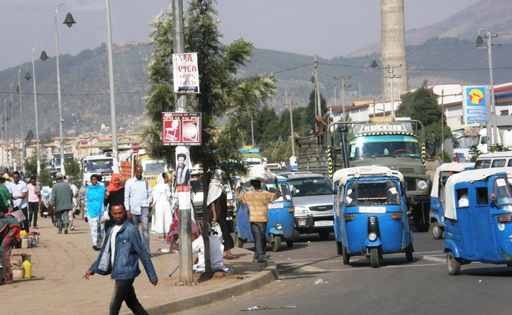13.1 The physical and the social environment
Everywhere you look, you see people, animals and plants living in fields and forests, streams and hillsides, or in villages, towns and cities. These are all part of the physical environment of the ‘real world’ that we can see with our eyes and touch with our hands. In your town, there are physical structures that humans have built or made, including houses, churches, mosques, schools, shops and market stalls, a health centre, kebele office or a police station.
Can you identify some other features of the physical environment in your town? (Figure 13.1 gives some clues.)
You may have mentioned roads and traffic, pavements, advertising signs, electricity cables and lamp-posts, or perhaps ditches to catch water and prevent flooding in the rainy season, which are not visible in Figure 13.1.

The physical structures we have mentioned also provide the local population with various kinds of social services. For example, a church or mosque provides religious services; a school provides education; shops and markets provide access to food and other products; roads provide transport links; and houses provide shelter. These services contribute to the social environment of the community. The social environment also includes the attitudes, beliefs, practices and traditions that are expressed by the members of a community. Unlike the physical structures, they cannot be seen.
Case Study 13.1 will help you to see the difference between the physical and the social environment. Read the case study and then answer the questions that follow it.
Case Study 13.1 Ato Belay interviews community members on their latrine use
Ato Belay was recently employed on an urban Health Extension project. He was given a task to prepare the annual plan of action on excreta management in his urban neighbourhood. He went house to house to collect data to identify who has, or has not, got a latrine, in order to design his plan of action. He recorded that less than 40% of households had latrines. The others were using open defecation and open urination in public places such as close to fences, around riverbanks, near waste containers or in the bush.
Ato Belay asked questions to find out why households do not have latrines, or do not use their latrine. Some said that constructing a latrine is too expensive. Others reported that collecting faeces in a latrine creates bad odour; they believed defecating in the open air is healthier because bad odour causes illness; others also said that open spaces have ‘good air’ when defecating. When Ato Belay asked about soiling the physical environment, some community members said: ‘Our ancestors never used latrines and the bush is not harmed by defecating there.’ Some people said that children should defecate in the open because latrines are only meant for adults. Others believed that children may be exposed to ‘evil’ influences emerging from the latrine pit if they use it at night. Ato Belay concluded that open defecation was the main sanitation problem in his community.
Now answer these questions:
- Which parts of the physical environment did Ato Belay ask about?
- What was the social environment he investigated?
- What was the public health problem he identified?
- What information does Ato Belay need to find out from community members in order to design his sanitation action plan?
The answers are as follows:
- The physical environments he asked about were latrines and the places where people urinated or defecated in the open.
- The social environment he investigated was the attitudes and beliefs of community members about using latrines and open defecation.
- The public health problem he identified was the widespread practice of open defecation by adults and children.
- Ato Belay needs to find out why residents are not using latrines even when the household has the facility, and why households without a latrine do not want to build one.
The part that the social environment plays in the above example demonstrates the importance of understanding why someone is defecating in the open or not using their latrine. So now we will look more closely at how the social environment influences WASH practices.
Learning Outcomes for Study Session 13
